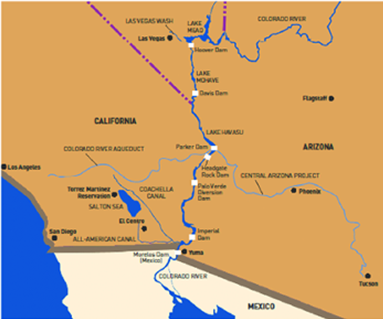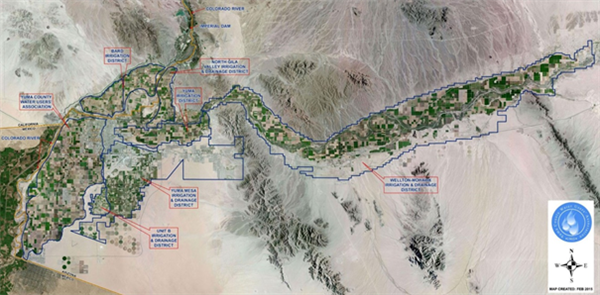
As part of the SW Ag Summit that recently took place in Yuma, we conducted a breakout session on Thursday, 23 February 2023 titled “Colorado River Water Shortage: Agricultural Perspectives”.
This session provided a brief review of the background and current situation on the Colorado River and included perspectives from members of the lower Colorado River agricultural community including the Palo Verde Valley, Imperial Valley, and the Yuma area irrigation districts. The program outline included the following participants:
Colorado River Water Shortage: Introductory Overview
Jeff Silvertooth, University of Arizona, Tucson, AZ
Colorado River Water Shortage: Palo Verde Valley Perspective
Bart Fisher, Fisher Ranch, Blythe, CA
Colorado River Water Shortage: Imperial Valley Perspective
Larry Cox, Lawrence Cox Ranches, Brawley, CA
Colorado River Water Shortage: Yuma Perspective
Elston Grubaugh, Wellton Mohawk Irrigation & Drainage District, Wellton, AZ
Moderator: Jeff Silvertooth
For geographic reference, Figures 1 and 2 provide maps of the lower Colorado River Valley and Yuma agricultural irrigation districts.
The session was not recorded but we do have each of the presentations available in the following links.
Jeff Silvertooth:
https://live-azs-vegetableipmupdates.pantheonsite.io/sites/default/files/2023-02/2023SWAS_JCS SWAS_ColoR Ag Perspectives_23feb23_FINAL_post.pdf
Bart Fisher:
https://live-azs-vegetableipmupdates.pantheonsite.io/sites/default/files/2023-02/2023SWAS_BF_SW%20Ag%20Summit%202023.pdf
Larry Cox:
https://live-azs-vegetableipmupdates.pantheonsite.io/sites/default/files/2023-02/2023SWAS_LC SWAS 23 February 2023.pdf
Elston Grubaugh:
https://live-azs-vegetableipmupdates.pantheonsite.io/sites/default/files/2023-02/2023SWAS_EG_02232023%20SW%20Ag%20Summit%20Panel_0.pdf
Also posted below is the link to an excellent video regarding Yuma Water and Ag that was recently developed and presented on 23 February by the Yuma Fresh Vegetable Association.
www.yumaagwater.com

Figure 1. Map of the lower Colorado River including the dams, diversions,
and some of the major canal systems.

Figure 2. Map of the Yuma area irrigation districts. Source: Yuma Water Users Association, 2015.
Frost and freeze damage affect countless fruit and vegetable growers leading to yield losses and occasionally the loss of the entire crop. Frost damage occurs when the temperature briefly dips below freezing (32°F).With a frost, the water within plant tissue may or may not actually freeze, depending on other conditions. A frost becomes a freeze event when ice forms within and between the cell walls of plant tissue. When this occurs, water expands and can burst cell walls. Symptoms of frost damage on vegetables include brown or blackening of plant tissues, dropping of leaves and flowers, translucent limp leaves, and cracking of the fruit. Symptoms are usually vegetable specific and vary depending on the hardiness of the crop and lowest temperature reached. A lot of times frost injury is followed by secondary infection by bacteria or opportunist fungi confusing with plant disease.
Most susceptible to frost and freezing injury: Asparagus, snap beans, Cucumbers, eggplant, lemons, lettuce, limes, okra, peppers, sweet potato
Moderately susceptible to frost and freezing injury: Broccoli, Carrots, Cauliflower, Celery, Grapefruit, Grapes, Oranges, Parsley, Radish, Spinach, Squash
Least susceptible to frost and freezing injury: Brussels sprouts, Cabbage, Dates, Kale, Kohlrabi, Parsnips, Turnips, Beets
More information:
Over the last couple of years, we identified and developed two high speed, precision spot sprayers to apply herbicides to weeds with minimal off-target spray while traveling at speeds that are viable for commercial vegetable farming operations (2 mph). The first is a spray assembly designed for controlling in-row weeds that are close to crop plants (1-cm spot spray resolution). The second is a high precision (sub-centimeter spot spray resolution) sprayer designed for spot spraying cotyledon stage weeds in spinach and leaf lettuce crops. We tested the device in the laboratory and found that weed control efficacy was greater than 95% (3 species), percentage of off-target spray was less than 3% and no crop injury was observed. The work was presented at the 2021 California Weed Science Society Annual Meeting. Click here or on the image below ) to view the presentation and see video of the devices in action.
We are now working towards developing a high precision, automated/robotic weeding machine for vegetable crops. This fall, Evan McGinnis, Biosystems Engineering Ph.D. candidate, initiated work to develop AI-based imaging software for detecting and targeting weeds. Once developed, the software will be integrated with the precision spot sprayer and tested in the field. Stay tuned for updates!
Acknowledgements
This work is supported by the Arizona Specialty Crop Block Grant Program and the USDA NIFA Specialty Crops Research Initiative USDA-NIFA-SCRI-004530. We greatly appreciate their support. Any opinions, findings, conclusions, or recommendations expressed in this publication are those of the author(s) and do not necessarily reflect the view of the U.S. Department of Agriculture.
Fig. 1. Images from “Centimeter Scale Resolution Sprayer for Precision In-Row Weed Control” presentation given at the 2021 California Weed Science Society Annual Meeting. Click here or on image to view the presentation.
Prefar (bensulide) is an organophosphate herbicide that has been used for more than 50 years in Arizona for lettuce production. In fact, it is one of the standard herbicides used for this purpose.
The University of Arizona Vegetable IPM Team conducted a Yuma County and Imperial Valley Survey evaluating a portion of the acres checked by Pest Control Advisors. The 2017 data indicated that in 58% of the lettuce acreage reported was treated with Prefar. Similarly, in the 2018 survey 52% received a Prefar application.
This product performs well when incorporated with sprinkler irrigation at stand establishment. It also works best in course textured soil’s such as the ones found in Coachella Valley, California. One of the weeds controlled by Prefar is pigweed (Amaranthus palmeri), which was found to be resistant to glyphosate herbicide in Arizona by Dr. William B. McCloskey in 2012. Other weeds are purslane (Portulaca oleracea), goosefoot (Chenopodium murale), Lambquarter (Chenopodium album), and some species of grasses.
The list of crops in which bensulide is used demonstrates the importance of this weed control tool for the agricultural industry.
According to the 1080 Pesticide Use Reporting Database provided by the Arizona Pest Management Center the list of crops includes: Arugula, Bok choy, Broccoli, Brussel Sprouts, Cabbage, Cantaloupe, Cauliflower, Celery, Cilantro, Corn, Cress, Endive, Fennel, Mustard, Kale, Lettuce, Onion, Parsley, Squash, Swiss chard, and others.
Please read the following contribution from Dr. Al Fournier on the EPA Notice- Petition to Revoke Organophosphate Tolerances: (including Bensulide).
Al Fournier, IPM Program Manager, Arizona Pest Management Center
10 August 2022
The EPA has extended its deadline for public comment on a Petition to Revoke Tolerances and Cancel Registrations for Certain Organophosphate Uses until September 25, 2022.
The petitioners, including United Farm Workers, Earthjustice, and several other groups, request that the Agency revoke all tolerances and cancel all associated registrations for food uses of 15 listed OPs, and further requests that the Agency complete its registration review process for these chemicals no later than October 1, 2022. The pesticides are currently at various stages of review, and the proposed deadline does not align with EPA’s published schedule to complete scientific reviews.
Among 15 Organophosphates named in the petition are 10 with reported uses in Arizona (bolded below). Those with known uses in lettuce and other produce include Bensulide (Prefar) and Acephate (Orthene).
Acephate, Bensulide, Chlorethoxyfos, Chlorpyrifos-methyl, Diazinon, Dichlorvos, Dicrotophos, Dimethoate, Ethoprop, Malathion, Naled, Phorate, Phosmet, Terbufos, Tribufos
Read the full EPA Notice here: https://www.regulations.gov/document/EPA-HQ-OPP-2022-0490-0001
To submit comments to the docket, use the following link: https://www.regulations.gov/commenton/EPA-HQ-OPP-2022-0490-0001
To contribute to Arizona Pest Management Center comments, contact Al Fournier
Results of pheromone and sticky trap catches can be viewed here.
Corn earworm: CEW moth counts remain at low levels in all areas, well below average for this time of year.
Beet armyworm: Trap increased areawide; above average compared to previous years.
Cabbage looper: Cabbage looper counts decreased in all areas; below average for this time of season.
Diamondback moth: DBM moth counts decreased in most areas. About average for this time of the year.
Whitefly: Adult movement beginning at low levels, average for early spring.
Thrips: Thrips adult counts reached their peak for the season. Above average compared with previous years.
Aphids: Aphid movement decreased in all areas; below average for late-March.
Leafminers: Adults remain low in most locations, below average for March.